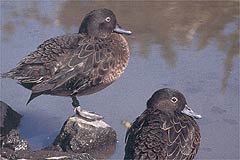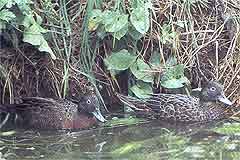|
|
|||
|
||||
|
Updated: September 12, 2001 |
|
|
|||||||||||||||||||||||||||||||||||||||||||||||||||||||||||||||||||||||||||||||||||||||||||||||||||
 Brown teal (pateke) usually feed at night |
|
 Brown teal prefer to live near still or slow flowing water |
Brown teal (Anas aucklandica) are an endemic wetland bird. They are small dark brown ducks standing 480mm high. Their wings are placed high on the their backs. They prefer heavily vegetated wetlands with still or slow-flowing open water. Pateke enjoy pastoral land among sedges and reeds where they flock and sun themselves. They are often found in the area between the salt water of the sea and the fresh water of rivers and estuaries.
The brown teal is a highly specialised duck which has disappeared from the mainland. They are mainly nocturnal omnivores. Their diet includes snails, worms and insects as well as roots and shoots of vegetation. Brown teal scoop their food from the water surface or mud. They feed in shallow water estuaries, freshwater wetlands, in peaty pools and sheltered coastal bays. They also fossick through seaweed on the beach or ground cover in the bush.
Pateke breed mainly between July to December with a peak in September/October. They form breeding pairs and defend small exclusive territories. They build a nest in thick sedges or rushes, making sure it isn't visible from above. The female makes a well worn path as she enters and leaves the nesting site. The male is also active in the brood rearing.
|
|
|
|
|
|
|
|
Dark brown Green sheen on head |
Warmth Flotation |
|
|
High on back Black brown |
Distracting predators Flying |
|
|
|
Bluish-black |
Eating shoots, roots insects, worms, snails Preening |
|
|
|
|
Walking Diving |
|
|
|
14 days to hatch Close to stream in sedge, reed clump Nest well hidden from above |
|